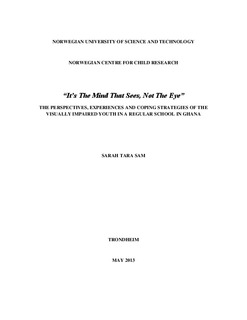| dc.contributor.advisor | Nilsen, Randi Dyblie | nb_NO |
| dc.contributor.author | Sam, Sarah Tara | nb_NO |
| dc.date.accessioned | 2014-12-19T14:37:39Z | |
| dc.date.available | 2014-12-19T14:37:39Z | |
| dc.date.created | 2014-01-06 | nb_NO |
| dc.date.issued | 2013 | nb_NO |
| dc.identifier | 683666 | nb_NO |
| dc.identifier.uri | http://hdl.handle.net/11250/269108 | |
| dc.description.abstract | Until recently, disabled children have been hidden from the lenses of research in both the social model of disability and the new sociology of childhood. In an attempt to give a voice to children with disability who are often objectified and silenced, this study aimed at exploring the experiences and coping strategies of visually impaired young people in a mainstream school in Ghana. The study further tried to explore views of children and young people with disability themselves who have been pushed to the background.
This study mainly aimed to gain insight into the experiences of visually impaired children in order to highlight its implications in a specific context; a mainstream or regular Ghanaian school context. In order to undertake this research, methods used included semi-participant observation; neighbourhood walks/guided tours, semi-structured interviews, joint interviews/ discussions and informal dialogues/conversations. The research was conducted with six main visually impaired participants while two other informants were only observed.
The study reveals that participants employed multiple perspectives of disability in nuanced ways and situations. These multiple disability perspectives include the medical model (disability as an illness, a defect); and disability as impairment (intellectual, physical and sensory impairments). Some participants employed the use of a local expression for persons with disability, thus revealing the social aspect of this view. Although alluding to the physical pain that accompanies their impairment (medical model), several participants emphasized that there were positive aspects to it such as sharpening of other senses. Most informants did not overtly subscribe to the notion that society ‗disables‘ them, yet latently implied this by noting that they faced some preventable challenges (with mobility and dependence) due to lack of societal consideration or provision (unfriendly terrain and Braille textbooks). Hence, participants did not seem to support the strict divide between the medical and social models. The visually impaired also saw their impairment cause as bio-medical but also spiritually caused by witches or as a punishment for familial actions. Thus bio-medical and spiritual (faith-healing) treatments were combined. However, the visually impaired revealed a change in perspective by revealing that they will seek bio-medical treatment primary to personal prayers to God since healing by God is done through medical practitioners.
The experiences of the visually impaired was characterised by dependence, inter-dependence and collaboration. Most instances of dependence resulted from an interaction between the interaction and a lack of resource provision; however the visually impaired expressed their agency in dealing with such situations. Other coping strategies involved the use of humour, positive self-evaluation and their Christian faith.
The study thus shows that educational and societal inclusion of persons with disabilities should consider the interaction between individual and societal barriers to functioning. | nb_NO |
| dc.language | eng | nb_NO |
| dc.publisher | Norges teknisk-naturvitenskapelige universitet, Fakultet for samfunnsvitenskap og teknologiledelse, Norsk senter for barneforskning | nb_NO |
| dc.title | "It‟s The Mind That Sees, Not The Eye": The Perspectives, Experiences and Coping Strategies of the Visually Impaired Youth in a Regular School in Ghana | nb_NO |
| dc.type | Master thesis | nb_NO |
| dc.contributor.department | Norges teknisk-naturvitenskapelige universitet, Fakultet for samfunnsvitenskap og teknologiledelse, Norsk senter for barneforskning | nb_NO |
